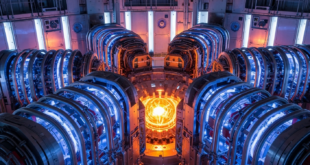Time crystals, a newly discovered phase of matter, have taken the world of physics by storm. Traditionally, matter has been categorized into three states: solid, liquid, and gas. However, time crystals represent a departure from this conventional classification. While traditional crystals exhibit spatial order and symmetries, time crystals extend this concept to temporal order. They possess a property called “time-translation symmetry breaking,” which means they oscillate between different states without the input of external energy. This perpetual oscillation is what sets time crystals apart from any known form of matter.
For deeper understanding of time crystals and applications please visit: Unveiling Time Crystals: Journey into a New Temporal Frontier
In addition to time crystals made of atoms and molecules, scientists have also created time crystals made of light. These are called photonic time crystals, and they are even more exotic than their atomic counterparts.
Photonic time crystals are made by creating a special type of optical lattice. An optical lattice is a regular array of light waves. When light waves are trapped in an optical lattice, they can form a time crystal.
The first photonic time crystal was created in 2017 by a team of scientists at the University of Geneva. The scientists used a special type of laser to create their optical lattice. They found that the light waves in the lattice spontaneously arranged themselves in a repeating pattern, and that the pattern changed over time.
The discovery of photonic time crystals was another major breakthrough in physics. It showed that time crystals are not limited to atoms and molecules. They can also be made of light.
Photonic time crystals have the potential to revolutionize a wide range of technologies. They could be used to create new types of sensors, computers, and even quantum computers.
In the quest to push the boundaries of scientific discovery, researchers have recently made a groundbreaking breakthrough by unlocking the potential of photonic time crystals. These mesmerizing structures offer the ability to amplify light and hold immense promise for revolutionizing future technologies. In this article, we delve into the world of photonic time crystals, exploring their remarkable properties and the exciting possibilities they present for various fields.
Understanding Photonic Time Crystals:
To comprehend the significance of photonic time crystals, it is essential to first grasp the concept of time crystals themselves. Time crystals were initially theorized by Nobel laureate Frank Wilczek in 2012. Unlike traditional crystals with repeating patterns in space, time crystals exhibit patterns that repeat in time. This captivating concept challenged conventional notions of physics and garnered significant interest from the scientific community.
Photonic time crystals, specifically, are time-based versions of optical materials. They consist of photons arranged in a pattern that repeats over time, resulting in synchronized and coherent photon behavior. This coherence leads to constructive interference and, remarkably, amplification of incident light.
Traditional optical amplifiers are based on electronic devices, such as transistors. However, these devices are limited in their performance and efficiency. Time crystals, on the other hand, offer a new and promising approach to optical amplification. Photonic time crystals are made of light, and they can amplify light without the need for electronic devices. This makes them much more efficient and scalable than traditional optical amplifiers.
By harnessing the unique properties of photonic time crystals, researchers aim to revolutionize various technological domains.
Recent Breakthrough
Scientists have achieved a significant breakthrough by creating two-dimensional photonic time crystals that can amplify light. This research, detailed in a paper published in Science Advances, holds immense potential for improving wireless communications and laser technology.
In this latest research, a team including scientists from Aalto University, the Karlsruhe Institute of Technology (KIT), and Stanford University focused on photonic time crystals, which are time-based versions of optical materials. The team fabricated photonic time crystals operating at microwave frequencies and demonstrated their ability to amplify electromagnetic waves. This discovery has far-reaching implications for wireless communication, integrated circuits, and laser technology.
Prior efforts in photonic time crystal research primarily concentrated on bulk materials, which presented significant challenges and limited practical applications. To overcome this, the team adopted a new approach by constructing a two-dimensional photonic time crystal, also known as a metasurface.
Reducing the dimensionality to a 2D structure made the implementation considerably easier, enabling the realization of photonic time crystals in practice. The team successfully fabricated a photonic time crystal and experimentally validated the theoretical predictions concerning its behavior. They demonstrated that photonic time crystals can amplify incident light with high gain, thanks to the synchronized and coherent arrangement of photons within the crystal. The periodic arrangement of photons also facilitates interactions that enhance amplification.
The applications of two-dimensional photonic time crystals are wide-ranging. By amplifying electromagnetic waves, they have the potential to enhance the power and efficiency of wireless transmitters and receivers. Coating surfaces with 2D photonic time crystals could address the issue of signal decay in wireless transmission. Additionally, photonic time crystals could simplify laser designs by eliminating the need for bulky mirrors typically used in laser cavities.
Overall, the creation of two-dimensional photonic time crystals represents a significant advancement in the field, with promising practical applications that could revolutionize wireless communications and laser technology.
Amplifying Light for Future Technologies:
One of the most promising applications of time crystals is in the field of optical amplification. Optical amplifiers are devices that can amplify light, and they are used in a wide variety of applications, including telecommunications, fiber optic sensors, and laser surgery.
Let’s explore some of the potential applications that could benefit from this groundbreaking discovery:
- Wireless Communications: Wireless communication systems play a vital role in our interconnected world. The use of photonic time crystals could significantly enhance wireless transmitters and receivers by boosting the power and efficiency of electromagnetic waves. This advancement could lead to faster data transfer rates, improved signal range, and more reliable connectivity.
- Fiber optic sensors: Photonic time crystals could be used to create fiber optic sensors, which are sensors that can measure physical quantities such as temperature, pressure, and strain. Fiber optic sensors are used in a wide variety of applications, including structural health monitoring, environmental monitoring, and medical diagnostics.
- Laser Technology: Laser technology has revolutionized numerous industries, ranging from manufacturing to medicine. Photonic time crystals hold the potential to simplify laser designs by eliminating the need for bulky mirrors traditionally used in laser cavities. This simplification could lead to more compact and efficient lasers, paving the way for advancements in laser-based technologies, such as precision machining, optical communications, and medical procedures.
- Ultra-fast lasers: Photonic time crystals could be used to create ultra-fast lasers, which are lasers that can emit pulses of light that are shorter than a picosecond (10-12 seconds). Ultra-fast lasers have a wide range of applications, including telecommunications, medical imaging, and material processing.
- Integrated Circuits: Integrated circuits are the backbone of modern electronics, powering everything from smartphones to supercomputers. The integration of photonic time crystals into integrated circuit designs could enable enhanced signal processing capabilities and improved circuit efficiency. This integration could potentially revolutionize computing and information processing systems, unlocking new levels of performance and energy efficiency.
- Quantum Technologies: Quantum technologies, including quantum computing and quantum communication, hold tremendous promise for solving complex problems and achieving unparalleled levels of information security. The introduction of photonic time crystals into the quantum realm could lead to advancements in quantum devices and systems. Their ability to maintain coherence over extended periods could help address the challenge of maintaining fragile quantum states, thus contributing to the development of more robust and reliable quantum technologies. Quantum computers have the potential to revolutionize a wide range of industries, including healthcare, finance, and energy.
Conclusion: The discovery and exploration of photonic time crystals have opened up new horizons in the realm of light manipulation and amplification. These artificial materials, with their unique ability to synchronize photons and amplify incident light, have the potential to revolutionize wireless communications, laser technology, integrated circuits, and quantum technologies. As researchers continue to unlock the mysteries surrounding photonic time crystals, we eagerly anticipate the transformative impact they will have on future technologies, leading us into a new era of scientific possibilities.
References and Resources also include:
https://scitechdaily.com/photonic-time-crystals-amplify-light-for-enhanced-communication-and-lasers/
 International Defense Security & Technology Your trusted Source for News, Research and Analysis
International Defense Security & Technology Your trusted Source for News, Research and Analysis


